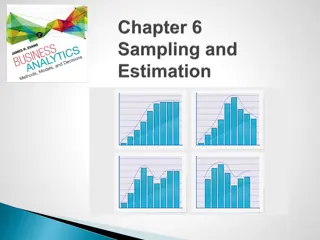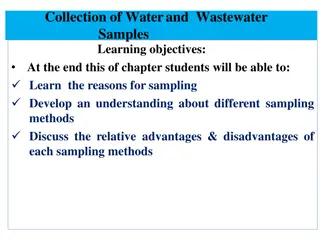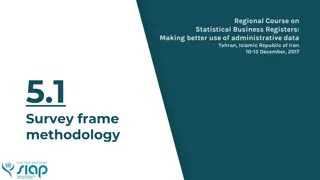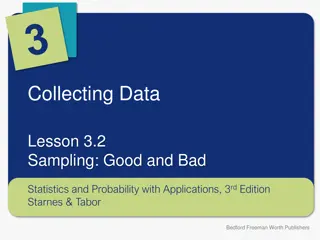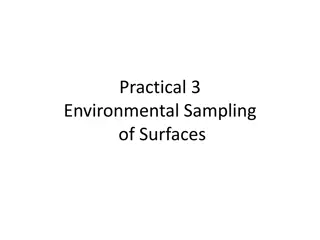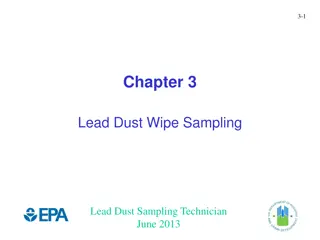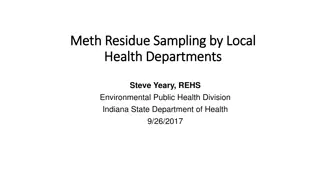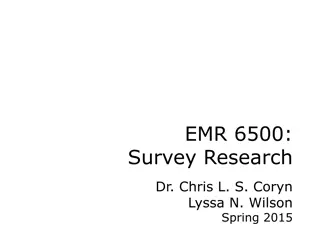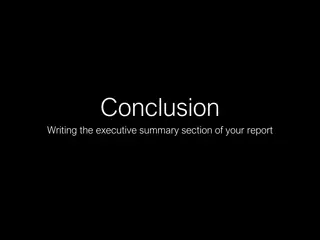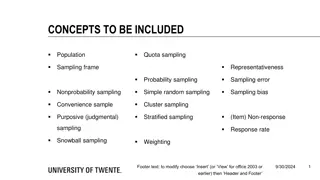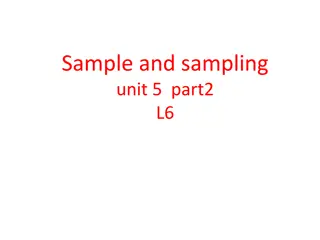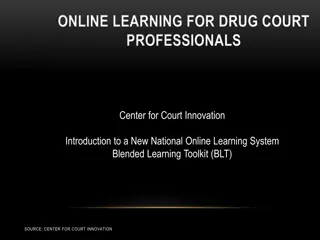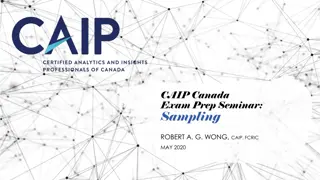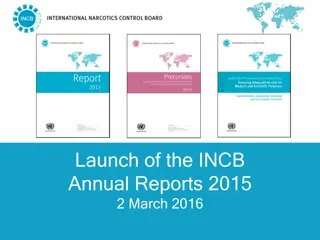Understanding Sampling Methods in Social Research
Sampling in social research involves selecting a subset of a population to make inferences about the whole. It helps in saving time and money, ensures accuracy in measurements, and allows estimation of population characteristics. The key principles of sampling include systematic selection, clear def
1 views • 19 slides
Understanding Sampling Methods in Statistical Analysis
Sampling is a crucial process in statistical analysis where observations are taken from a larger population. Different sampling techniques are used based on the analysis being performed. Sampling methods help in studying populations when studying the entire population is not feasible. There are two
0 views • 8 slides
Sampling Under the RRF - General Principles and Methods
Sampling under the RRF is essential for the Commission to ensure reasonable assurance of fulfillment of numerical milestones or targets. The approach involves statistical risk-based random sampling with specific thresholds and considerations for different types of milestones. Various statistical tab
0 views • 12 slides
Understanding Non-Probability Sampling Methods
Non-probability sampling methods involve selecting samples based on subjective judgment rather than random selection. Types include convenience sampling, quota sampling, judgmental (purposive) sampling, and snowball sampling. Convenience sampling picks easily available samples, quota sampling select
2 views • 7 slides
Systematic Analysis of Real Samples in Analytical Chemistry
This analysis covers the systematic process involved in analyzing real samples, including sampling, sample preservation, and sample preparation. It discusses the importance of accurate sampling in obtaining information about various substances, such as solids, liquids, gases, and biological material
0 views • 54 slides
Polymeric Controlled Drug Delivery Systems
Polymeric controlled drug delivery systems play a crucial role in regulating drug release through diffusion, solvent penetration, and chemical mechanisms. These systems include diffusion-controlled, solvent-controlled, and chemically-controlled devices, each operating based on specific principles. S
0 views • 33 slides
Understanding Sampling Plans in Statistical Analysis
Sampling is vital for statistical analysis, with sampling plans detailing objectives, target populations, operational procedures, and statistical tools. Different sampling methods like judgmental, convenience, and probabilistic sampling are used to select samples. Estimation involves assessing unkno
1 views • 36 slides
Introduction to Sampling in Statistics
Sampling in statistics involves selecting a subset of individuals from a population to gather information, as it is often impractical to study the entire population. This method helps in estimating population characteristics, although it comes with inherent sampling errors. Parameters represent popu
2 views • 24 slides
Understanding Nasopulmonary Drug Delivery System
Nasopulmonary drug delivery system, utilizing the nasal route for drug administration, offers advantages such as hepatic first-pass metabolism avoidance and rapid drug absorption. This system is beneficial for pharmacologically active compounds with poor stability in gastrointestinal fluids. While i
0 views • 35 slides
Understanding Sampling Methods and Errors in Research
Sampling is crucial in research to draw conclusions about a population. Various methods like simple random sampling, stratified sampling, and systematic sampling help in selecting representative samples. Sampling error arises due to differences between sample and population values, while bias leads
0 views • 12 slides
Fundamentals of Food Sampling and Analysis
Discover the key methods and procedures for sampling, transportation, and storage of environmental parameters, focusing on food sampling and analysis. Explore the importance of representative samples, quality analysis results, and risks associated with sampling. Learn about homogeneous vs. heterogen
5 views • 36 slides
Understanding Random Sampling and RAT-Stats in Statistical Analysis
Explore the concepts of random sampling, RAT-Stats, and their application in statistical analysis. Learn about sampling processes, common terms, precision points, and when to use these methods. Discover the steps involved in the sampling process and how it can be utilized in various audit and monito
2 views • 18 slides
Sampling Methods and Requirements for Water and Wastewater Analysis
The collection of water and wastewater samples is crucial for accurate analysis and monitoring. Understanding the reasons for sampling, different methods, and the importance of sample preparation is essential for obtaining reliable results. Planning sampling, meeting specific requirements, and selec
6 views • 22 slides
Importance of In-Vitro Dissolution Testing in Drug Assessment
In drug development, in-vitro dissolution testing plays a crucial role in evaluating drug release from tablets when in-vivo bioavailability studies are limited. By ensuring drug release is close to 100% and uniform batch to batch, these tests help assess drug availability and effectiveness. Regulato
11 views • 10 slides
Understanding Analog Data and Digital Signal Transmission
This lecture delves into the concepts of analog data, digital signals, and the processes involved in data transmission and digital communication. It covers topics such as Pulse Amplitude Modulation (PAM), Analog-to-Digital Conversion, and Sampling. The conversion of analog signals to digital signals
0 views • 34 slides
Understanding Quantitative Aspects of Drug Action
Explore the quantitative aspects of drug action, including drug receptor binding, concentration binding curves, dose-response curves, and types of antagonism. Learn to relate drug concentration to receptor binding capacity and response produced. Discover how concentration binding curves and dose-res
0 views • 29 slides
Understanding Sampling and Signal Processing Fundamentals
Sampling plays a crucial role in converting continuous-time signals into discrete-time signals for processing. This lecture covers periodic sampling, ideal sampling, Fourier transforms, Nyquist-Shannon sampling, and the processing of band-limited signals. It delves into the relationship between peri
1 views • 60 slides
Understanding Sampling Frames in Statistical Business Registers
Sampling frames play a crucial role in surveys by providing a snapshot of statistical units needed for data collection. Key points include creating appropriate sampling frames, specifying target populations and variables of interest, and choosing the right statistical units based on the type of data
0 views • 20 slides
Understanding Biases in Sampling Methods
Statistical studies rely on samples to draw conclusions about populations, but the method of sampling can introduce biases. This text discusses convenience sampling, voluntary response sampling, random sampling, and the implications of biased sampling methods on study results. It highlights how bias
1 views • 12 slides
Insights into Recent Progress on Sampling Problems in Convex Optimization
Recent research highlights advancements in solving sampling problems in convex optimization, exemplified by works by Yin Tat Lee and Santosh Vempala. The complexity of convex problems, such as the Minimum Cost Flow Problem and Submodular Minimization, are being unraveled through innovative formulas
1 views • 47 slides
Guide to Environmental Surface Sampling Techniques
Understanding the importance of environmental surface sampling is crucial for ensuring hygiene and safety. This guide covers key aspects such as pre-sampling considerations, aseptic techniques, major sampling methods like RODAC plate, swab, and wipe methods, along with detailed procedures for each m
1 views • 16 slides
Lead Dust Wipe Sampling Techniques and Guidelines
This resource provides valuable information on lead dust wipe sampling techniques for Lead Dust Sampling Technicians. It covers the objectives, measuring lead dust, sampling strategy, sampling locations based on EPA RRP Rule, and HUD clearance regulations. Techniques for taking dust wipe samples, id
2 views • 41 slides
Comprehensive Guidelines for Meth Residue Sampling by Local Health Departments
This detailed guide outlines the procedures and protocols for meth residue sampling conducted by local health departments. It covers the reasons for sampling, the importance of qualified inspectors, testing methodologies, sampling kits assembly, and more. Key points include when and why sampling is
0 views • 19 slides
Understanding Sampling in Survey Research
This content covers essential concepts of survey research, statistics, and sampling methods. It delves into elements of the sampling problem, technical terms, and how to select a sample for surveys. The discussions revolve around population parameters, sampling procedures, and the control of informa
1 views • 39 slides
Understanding Sampling in Social Research Methods
Sampling in social research involves selecting a portion of a population to draw conclusions about the entire group. It helps save time, money, and allows for accurate measurements. The key principles of sampling include systematic selection, clear definition of sample units, independence of units,
0 views • 19 slides
Understanding Non-Probability Sampling Methods
Non-probability sampling involves selecting samples based on subjective judgment rather than random selection, leading to a lack of equal chances for all population members to participate. Various types include convenience sampling, quota sampling, judgmental sampling, and snowball sampling. Conveni
1 views • 7 slides
Understanding Sampling in Artificial Intelligence: An Overview
Exploring the concept of sampling in artificial intelligence, particularly in the context of Bayesian networks. Sampling involves obtaining samples from unknown distributions for various purposes like learning, inference, and prediction. Different sampling methods and their application in Bayesian n
2 views • 29 slides
Approximate Inference in Bayes Nets: Random vs. Rejection Sampling
Approximate inference methods in Bayes nets, such as random and rejection sampling, utilize Monte Carlo algorithms for stochastic sampling to estimate complex probabilities. Random sampling involves sampling in topological order, while rejection sampling generates samples from hard-to-sample distrib
0 views • 9 slides
State Crime Lab Drug Sampling Protocols
Using the State Crime Lab's drug sampling protocols for defense involves understanding three sampling methods: administrative sample selection, threshold sample selection, and hypergeometric sampling plan. The hypergeometric plan allows experts to make assumptions about the chemical composition of u
0 views • 30 slides
Impact of Socioeconomic Conditions on Drug Use Disorders: Insights from World Drug Report 2020
The World Drug Report 2020 highlights the strong correlation between socioeconomic factors and drug use disorders. Studies reveal that communities facing poverty, violence, and social inequality are at a higher risk of drug overdoses and addiction. Factors like income inequality, lack of social capi
1 views • 17 slides
Understanding Sampling Variability in Statistical Analysis
Random sampling is crucial in statistical analysis to minimize sampling error. Sampling variability occurs due to chance when a random sample is surveyed instead of the entire population. Different units selected can lead to slightly varied estimates. It's important to understand and address samplin
1 views • 31 slides
Understanding Targeted Clinical Investigation in Pharmacovigilance
Targeted clinical investigation plays a crucial role in pharmacovigilance by further evaluating significant risks identified in pre-approval clinical trials. This involves conducting pharmacokinetic and pharmacodynamic studies, genetic testing, interaction studies, and large simplified trials to ass
0 views • 12 slides
Understanding Non-Probability Sampling Methods
Non-probability sampling involves selecting samples based on subjective judgement rather than random selection. This method may not give all population members an equal chance to participate. Types include convenience sampling, quota sampling, judgemental sampling, and snowball sampling.
0 views • 7 slides
Understanding Sampling Methods in Research
Explore key concepts in sampling such as probability and non-probability methods, sampling error, representativeness, and types of biases. Learn about the importance of sampling in research, theoretical variables, conceptualization, and operationalization. Evaluate different types of sampling proces
1 views • 20 slides
Understanding Non-Probability Sampling Techniques in Nursing Research
Non-probability sampling in nursing research involves selecting samples subjectively rather than randomly. This sampling method carries a higher risk of bias and limits statistical inference about the entire population. Five main types include convenience, purposive, quota, snowball, and voluntary r
0 views • 30 slides
Advances in Ophthalmic Drug Delivery Systems
This content explores various advanced ophthalmic drug delivery systems including erodible ophthalmic inserts, soluble ocular drug inserts, new ophthalmic drug delivery systems, and bioadhesive ophthalmic drug inserts. These innovative systems aim to provide accurate dosing, prolonged drug release,
0 views • 8 slides
Innovative Online Learning for Drug Court Professionals
Center for Court Innovation has introduced a new National Drug Court Online Learning System aimed at assisting drug court professionals. This system offers free access to web-based training, expert video lessons, virtual site visits to drug treatment courts, practitioner interviews, and a resource l
0 views • 8 slides
Understanding Drug Testing Policies in the Workplace
The Drug-Free Workplace Act of 1988 mandates federal grant recipients to implement zero-tolerance drug policies to maintain a drug-free environment. Employers must establish clear policies, conduct awareness programs, offer counseling and rehabilitation services, and impose penalties for violations.
0 views • 19 slides
Understanding Sampling: Importance, Process, and Errors Explained
This content delves into the world of sampling, exploring why sampling is crucial, the sampling process involving defining populations and calculating sample sizes, and the distinction between non-sampling and sampling errors. It covers the significance of representative samples, common errors in sa
0 views • 15 slides
Overview of International Drug Control Efforts and Challenges in 2015-2016
The content highlights significant events related to international drug control efforts, emphasizing the launch of the INCB Annual Reports, the UNGASS session at the United Nations, and the focus on health, welfare, and challenges in combating drug abuse. It discusses issues such as new psychoactive
0 views • 13 slides






